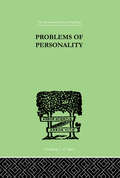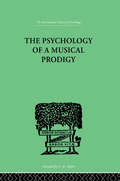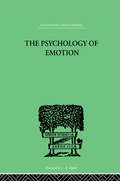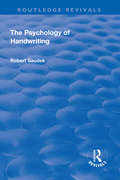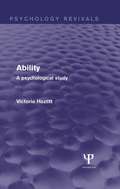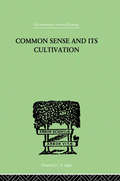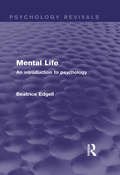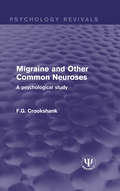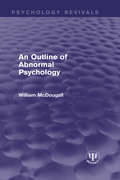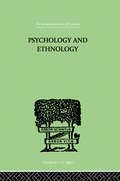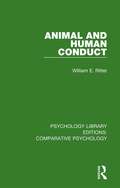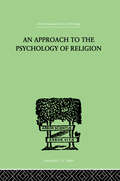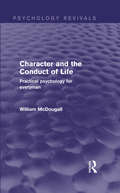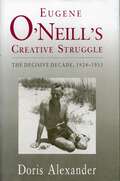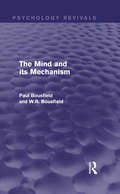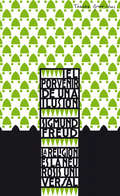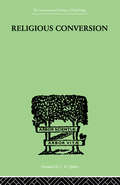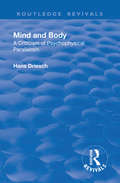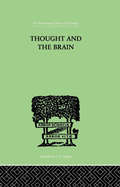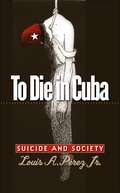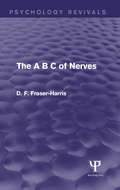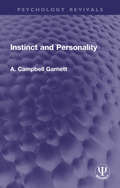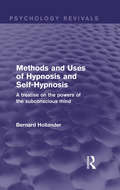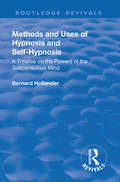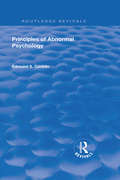- Table View
- List View
Problems of Personality: Studies Presented to Dr Morton Prince, Pioneer in American (International Library Of Psychology Ser. #Vol. 4)
by C. Macfie Campbell H. S. Langfeld Wm Mcdougall A. A. Roback E. W. TaylorThis is Volume IV of a series of twenty-one on Individual Differences. Originally published in 1925, this is a collection of essays and studies presented to Dr Morton Prince, pioneer in American psychopathology.
The Psychology of a Musical Prodigy (International Library Of Psychology Ser.)
by Revesz, GFirst published in 1999. Routledge is an imprint of Taylor & Francis, an informa company.
The Psychology of Emotion: Morbid and Normal (International Library Of Psychology)
by MacCurdy, John TThis is Volume XII of nineteen in a collection of Abnormal and Clinical Psychology. Originally published in 1925, this research stemmed from many discussions about the applicability of psychoanalytic principles to manic-depressive insanity, whether the symptoms could be traced to unconscious mental processes in the same way as Jung had demonstrated it to be possible in dementia praecox and ended up with the general objective moving from that of psychopathological to one of psychological conclusions .
Revival: The Psychology of Handwriting (Routledge Revivals)
by Robert SaudekGraphology, in English and American manuals of handwriting, stands in the relation with all other pseudo-sciences, founded on half truths and wrought with superstition and amateur fads, compared to modern science. In this book, the author attempts to put before the English public the fundamental principles, methods and laws of scientific graphology. Contents: common objections to graphology and their refutation; history of graphology; physiology and psychology of writing; random test of the correctness of methods explained; practical hints for drawing up of graphological analyses; specimens of analysis.
Ability: A Psychological Study (Psychology Revivals)
by Victoria HazlittOriginally published in 1926, the first part of this book attempted to formulate a theory of ability in the light of recent experimental results of the time. It discusses the nature of intelligence and the problem of special abilities, and includes a study of some typical forms of genius. The second part gives an account of a three years’ experimental study of special abilities in arts and science respectively, carried out upon university students. Samples of the tests employed are included. The results are presented in non-technical form. Victoria Hazlitt was a pioneer of experimental psychology, which was particularly significant as a woman in the early twentieth century. In many cases her work anticipated later developments in psychology by many years. Today it can be enjoyed in its historical context.
Common Sense And Its Cultivation (International Library Of Psychology Ser. #Vol. 40)
by Hankin, E HanburyFirst published in 1999. Routledge is an imprint of Taylor & Francis, an informa company.
Mental Life: An Introduction to Psychology (Psychology Revivals)
by Beatrice EdgellOriginally published in 1926, the aim of this textbook was the ‘interpretation of human behaviour and conduct’. Beatrice Edgell is an important figure in the history of psychology. She was the first British woman to receive a PhD in psychology, the first female psychology professor in Britain and the first woman president of the British Psychological Society (1930-1931), of which she had been a founding member in 1901. As the Head of Psychology at Bedford College, she established one of the first psychological laboratories in the UK. She also taught a number of women who went on to become prominent in the field. One of her many publications this book was thought to be ‘suitable for students training for social work or for the general reader interested in educational and social questions’.
Migraine and Other Common Neuroses: A Psychological Study (Psychology Revivals)
by F.G. CrookshankOriginally published in 1926, as part of the Psyche Miniatures Medical Series, this title is based on two lectures given to the North-East London Clinical Society and the North-East London Post Graduate College respectively. Francis Graham Crookshank was a British epidemiologist, and a medical and psychological writer. Today it can be read and enjoyed in its historical context.
An Outline of Abnormal Psychology (Psychology Revivals)
by William McDougallOriginally published in 1926, a complement to the author’s Outline of Psychology, this book surveys the field of neurotic and mental disorders in so far as they are not due to gross organic lesions. It discusses this principal types of mental process that are abnormal or disorderly in the sense that they are departures from the fully waking processes of the normal mind, seeking to understand them in terms of the general principles laid down in the earlier volume. Sleep, the influence of drugs and suggestion, conflict and repression, automatisms and somnambulisms, morbid fears, obsessions and impulsions, perversions, delusions, exaltation and depression, multiple personalities, psycho-therapy, and the schools of abnormal psychology – these and many others are the topics discussed from the point of view, not of medical practice, but of psychological theory. A book, not for the medical expert only, but for every man or woman interested in the riddle of human personality.
Psychology and Ethnology (International Library Of Psychology Ser. #Vol. 36)
by W H RiversFirst published in 1999. Routledge is an imprint of Taylor & Francis, an informa company.
Animal and Human Conduct (Psychology Library Editions: Comparative Psychology)
by William E. RitterOriginally published in 1928, this title looks at the link between animal and human conduct. It had long been recognized on the basis of their activities that many animals possess minds, and that these are similar in a considerable number of respects to human minds. According to the author, this book looks at man’s position within nature from the perspective of a naturalist, rather than a psychologist or philosopher. He has attempted to describe the working of mind and body in human beings and in other living things; to examine critically the mental technique involved in such descriptions; and to reason broadly as to the bearings of the facts and processes on human life. Now it can be read and enjoyed in its historical context.
An Approach To The Psychology of Religion (International Library Of Psychology Ser. #Vol. 33)
by Cyril J. FlowerFirst published in 1999. Routledge is an imprint of Taylor & Francis, an informa company.
Character and the Conduct of Life: Practical Psychology for Everyman (Psychology Revivals)
by William McDougallFirst published in 1927, the preface reads: "It is directed to men and women of goodwill who are not completely satisfied with themselves, who believe that by taking thought they may add, however little, to their moral stature and to their efficiency in working towards whatever goals they may have adopted. The book is an essay in practical morals and is not at all concerned with ethical theories." A fascinating glimpse into psychology and morals from the early twentieth century, including chapters for young people, parents and children, husbands and wives!
Eugene O'Neill's Creative Struggle: The Decisive Decade, 1924–1933
by Doris AlexanderIn Eugene O'Neill's Creative Struggle, Doris Alexander gives us a new kind of inside biography that begins where the others leave off. It follows O'Neill through the door into his writing room to give a blow-by-blow account of how he fought out in his plays his great life battles—love against hate, doubt against belief, life against death—to an ever-expanding understanding. It presents a new kind of criticism, showing how O'Neill's most intimate struggles worked their way to resolution through the drama of his plays. Alexander reveals that he was engineering his own consciousness through his plays and solving his life problems—while the tone, imagery, and richness of the plays all came out of the nexus of memories summoned up by the urgency of the problems he faced in them. By the way of O'Neill, this study moves toward a theory of the impulse that sets off a writer's creativity, and a theory of how that impulse acts to shape a work, not only in a dramatist like O'Neill but also in the case of writers in other mediums, and even of painters and composers. The study begins with Desire Under the Elms because that play's plot was consolidated by a dream that opened up the transfixing grief that precipitated the play for O'Neill, and it ends with Days Without End when he had resolved his major emotional-philosophical struggle and created within himself the voice of his final great plays. Since the analysis brings to bear on the plays all of his conscious decisions, ideas, theories, as well as the life-and-death struggles motivating them, documenting even the final creative changes made during rehearsals, this book provides a definitive account of the nine plays analyzed in detail (Desire Under the Elms, Marco Millions, The Great God Brown, Lazarus Laughed, Strange Interlude, Dynamo, Mourning Becomes Electra, Ah, Wilderness!, and Days Without End, with additional analysis of plays written before and after.
The Mind and its Mechanism (Psychology Revivals)
by W.R. Bousfield Paul BousfieldFirst published in 1927, the original blurb reads: "Scientists are beginning to believe there is some immaterial thing which performs certain functions that the material mechanism of the brain is powerless to perform. It is the purpose of this book to explain what that immaterial thing is and how it functions. The Mind and Its Mechanism deals with a theory that may conceivably influence the study of psychology, and will interest not only psychologists, but physiologists, physicists and biologists." Now back in print, this title can be read and enjoyed in its historical context.
El porvenir de una ilusión (Serie Great Ideas #Volumen 16)
by Sigmund FreudIdeas que han cambiado el mundo. A lo largo de la historia, algunos libros han cambiado el mundo. Han transformado la manera en que nos vemos a nosotros mismos y a los demás. Han inspirado el debate, la discordia, la guerra y la revolución. Han iluminado, indignado, provocado y consolado. Han enriquecido vidas, y también las han destruido. Taurus publica las obras de los grandes pensadores, pioneros, radicales y visionarios cuyas ideas sacudieron la civilización y nos impulsaron a ser quienes somos. Este estudio de la religión de la mano del psicoanalista más célebre del siglo XX examina el papel que la fe puede desempeñar en la vida del hombre, lo que significa para nosotros y por qué, como especie, tendemos hacia ella. Comentarios sobre la colección Great Ideas:«De veras que la edición es primorosa y pocas veces contenido y continente pueden encontrarse mejor ensamblados y unidos. ¡Qué portadas! Para enmarcar. [...] Ante las Great Ideas, solo cabe quitarse el sombrero. ¡Chapeau!»ABC «Taurus propone un doble envite con este lanzamiento. Por un lado aumenta su compromiso con el ensayo; por otro, recupera el gusto por la estética. A los volúmenes se les ha proporcionado una portada delicada y cuidada (copian el original británico) que invita a la lectura.»La Razón «Un fenómeno editorial.»The Guardian «Aparte de los contenidos, en general muy bien elegidos, son tan bonitos que si los ven seguro que cae alguno.»El País «Ideas revolucionarias, crónicas de exploraciones, pensamientos radicales... vuelven a la vida en estas cuidadísimas ediciones, muy atractivas para nuevos lectores.»Mujer Hoy «Grandes ideas bien envueltas. De Cicerón a Darwin, esta colección entra por los ojos.»Rolling Stone «Original y bella iniciativa la emprendida por Taurus con su colección Great Ideas.» Cambio 16 «Hay libros inmortales, libros únicos que contienen pensamientos y reflexiones capaces de cambiar el mundo, tesoros en miniatura reagrupados en la colección Great Ideas.»Diario de León
Religious Conversion: a Bio-Psychological Study
by Sante de SanctisThis is Volume II of six in a collection on Psychology and Religion. Originally published in 1927, this is a Bio-Psychological study with a special aim (the reconstruction of the empirical Ego), and its own method (introspection).
Revival: Mind and Body: A Criticism of Psychophysical Parallelism (Routledge Revivals)
by Hans DrieschThis little book is not a text-book of psychology. It is exclusively concerned with one particular psychological problem, a problem, however, that stands at the very centre of psychology. The relations between mind and body are analysed; that is to say, the following three psychedelic problems are successively raised: What is the mind? What is the body? What are the relations between mind and body? But it is only the third problem which is extensively dealt with; the first two are only briefly defined.
Thought and the Brain (International Library Of Psychology Ser.)
by Piron, HenriFirst Published in 1999. Routledge is an imprint of Taylor & Francis, an informa company.
To Die in Cuba
by Louis A. PérezFor much of the nineteenth century and all of the twentieth, the per capita rate of suicide in Cuba was the highest in Latin America and among the highest in the world--a condition made all the more extraordinary in light of Cuba's historic ties to the Catholic church. In this richly illustrated social and cultural history of suicide in Cuba, Louis A. Perez Jr. explores the way suicide passed from the unthinkable to the unremarkable in Cuban society.In a study that spans the experiences of enslaved Africans and indentured Chinese in the colony, nationalists of the twentieth-century republic, and emigrants from Cuba to Florida following the 1959 revolution, Perez finds that the act of suicide was loaded with meanings that changed over time. Analyzing the social context of suicide, he argues that in addition to confirming despair, suicide sometimes served as a way to consecrate patriotism, affirm personal agency, or protest injustice. The act was often seen by suicidal persons and their contemporaries as an entirely reasonable response to circumstances of affliction, whether economic, political, or social.Bringing an important historical perspective to the study of suicide, Perez offers a valuable new understanding of the strategies with which vast numbers of people made their way through life--if only to choose to end it. To Die in Cuba ultimately tells as much about Cubans' lives, culture, and society as it does about their self-inflicted deaths.For much of the nineteenth century and all of the twentieth, the per capita rate of suicide in Cuba was the highest in Latin America and among the highest in the world--a condition made all the more extraordinary in light of Cuba's historic ties to the Catholic church. In this richly illustrated social and cultural history of suicide in Cuba, Louis A. Perez Jr. explores the way suicide passed from the unthinkable to the unremarkable in Cuban society. To Die in Cuba ultimately tells as much about Cubans' lives, culture, and society as it does about their self-inflicted deaths.-->
The A B C of Nerves (Psychology Revivals)
by D.F. Fraser-HarrisOriginally published in 1928, the preface reads: "It is almost impossible to distinguish between what is ‘elementary’ and what is ‘advanced’ in regard to the nervous system. The constitution and functions of that system are so little matters of common knowledge that it would be safe to assume that practically nothing of its physiology is known to the ordinary reader. The selection of what is necessary to be known and likely to be comprehended by readers who have no previous knowledge of anatomy and physiology is, therefore, no easy task. It is certain that in the opinion of some authorities much has been omitted that should have been included; one can but say in self-defence that to have included more than is here considered would have exceeded the limits of a treatise whose title is the A B C." Today it can be read and enjoyed in its historical context.
Instinct and Personality (Psychology Revivals)
by A. Campbell GarnettOriginally published in 1928, the principle aim of this book was to present and apply an original viewpoint in psychology. The work is substantially that of a thesis on "The Problem of Personality in the Light of Recent Psychology" for which the author was awarded the degree of Doctor of Letters in the University of Melbourne in 1925. Today it can be read and enjoyed in its historical context.
Methods and Uses of Hypnosis and Self-Hypnosis: A Treatise on the Powers of the Subconscious Mind (Psychology Revivals)
by Bernard HollanderOriginally published in 1928, the main object of this book was to draw attention to the importance of hypnotism and its phenomena, in order to stimulate inquiry into what was at the time a ‘mysterious and unexplored subject’. The author had studied hypnotism nearly all his life and practised it for thirty years, he therefore felt the investigations, experiences, and views presented in this title would prove of interest and value both to the medical and psychological expert and the general reader of the time. Today it can be read and enjoyed in its historical context.
Revival: A Treatise on the Powers of the Subconscious Mind (Routledge Revivals)
by Bernard HollanderThe main object of this book is to draw attention to the importance of hypnotism and its phenomena, in order to stimulate inquiry into what is still a mysterious and unexplored subject. This I have already endeavoured to do in an earlier book – Hypnotism and Suggestion in Daily Life, Education and Medical Practice – published in 1910, since when I have gained so much additional experience that an entirely new work is but justice.
Revival: Principles of Abnormal Psychology (Routledge Revivals)
by Edmund Smith ConklinThe literature since the first edition has been reviewed and material from it has been inserted, with particular emphasis on experimental contributions. Major additions are made in the sections on speech abnormalities, constitutional psychopathic inferiority, behavior effects of epidemic encephalitis, and psychotherapy. The chapters on psychoneuroses now precede those on the psychoses. The revised work consists of 21 chapters and an index; bibliographies are presented in footnotes and at the ends of chapters.
